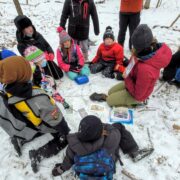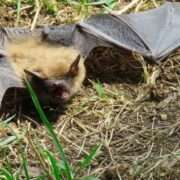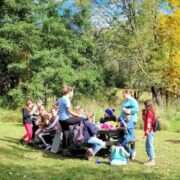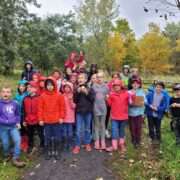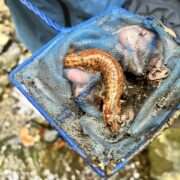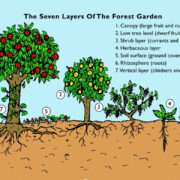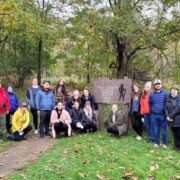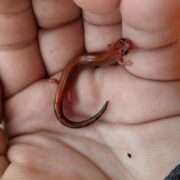We have two salamander studies currently underway on the Massawippi Trust conserved lands.
Why study these particular creatures?
They are small and mighty indicators of the health of the environment.
They are one of three orders of amphibians which include frogs and toads and Caecilians (limbless amphibians found only in the tropics). There are approximately 400 species of Salamanders worldwide ranging in size from 4 cm to 1.5 m! One third of the planet’s amphibian species are threatened with extinction.
Quebec is home to 10 species of salamanders, including two species that are found only in Quebec: the purple salamander and the mountain dusky salamander. The purple salamander lives on our protected lands in the Lake Massawippi watershed.They are mostly short-bodied, long-tailed organisms with four legs and moist skin. The purple salamander, a variety of the brook salamander, has no lungs! How does it survive? It “breathes” through its moist skin. It can only survive near very small, medium-sized mountain streams. It needs flat rocks and clear, pure water. A high water flow probably indicates the presence of fish, its predators. It lives at the top of the stream, in the shade, in the forest, where the water is fresh. It lays its eggs on the underside of rocks. As its life cycle is characterized by a long larval period (from three to six years), the environment and the climatic conditions must be stable to ensure its survival.
They are nocturnal creatures. They spend their days underground or under the cover of moist leaves, so unless you are a midnight hiker, chances are you won’t see them. They are sensitive to any changes in water quality, air temperature, and humidity. They are both prey and predator and as such are often used as an indicator of ecosystem health. These cold blooded creatures have such specialized ecological niches, which are threatened by climate change and rising temperatures, that they are considered bio indicators (species used to assess the quality of the environment and its changes over time) of climate change.
Salamanders control pests by eating insects like mosquitos. They also eat tadpoles and aquatic invertebrates. They are food for larger animals like birds, mammals, snakes and other invertebrates. They occupy an important position in the food web. Anything which impacts their prey or their predators will be reflected in the salamander population. Other organisms rely on them.
A change in acidity in breeding ponds or a drop in ambient water and they die. Their moist, permeable skin makes them vulnerable to drought and toxic substances. They are considered the “canary in the coal mine” because they are so susceptible to small changes in the habitat and as such as are exceptional indicators of ecosystem health.
In Quebec, agricultural and silvicultural effluents, causing the addition of sediments and the alteration of water quality, constitute the threat the most negative impact on the species according to the experts. They give it a high impact rating. Among the other threats, three categories also have a moderate impact on populations management and water use, transportation and service corridors, and logging. (Translation of text found in ref. page 7 https://mffp.gouv.qc.ca/documents/faune/PL_retablissement_salamandre-pourpre_2021-2031.pdf French version is the official version.)
Salamanders promote resilience in the ecological niche, they…
- control the population of pests by eating them.
- contribute to soil health by secreting valuable micronutrients from their skin as the burrow underground.
- Maintain carbon stores by controlling bug population who would otherwise eat off the leafy woodland floors. By maintaining the leaf coverage, they also help store the carbon.
- Help contribute to the maintenance of healthy headwater streams
“Their contribution to headwater stream maintenance is one of the most important offerings they (unwittingly) make to the human world. The health of our major waterways — rivers, lakes and streams — emanates directly from headwater stream health, and these waterways feed into underground aquifers that supply clean drinking water to humans.” said Sarah Jay in Discover Magazine (https://www.discovermagazine.com/planet-earth/salamanders-can-do-what)
Her article is based on the finding of scientists Best, M. L.; Welsh, H. H., Jr. 2014. The trophic role of a forest salamander: impacts on invertebrates, leaf litter retention, and the humification process. Ecosphere 5(2): article 16. (ref. https://www.fs.usda.gov/treesearch/pubs/45487)
Impactful research and findings!
Other researchers from the University of Missouri-Columbia as reported in the Science Daily said:
“Salamanders typically live underground. They live in places most people don’t see, and they live in these small, headwater streams where there are no other fresh-water vertebrates. Fish can’t exist in these small streams. This is where water seeps out of the rock, where all streams begin life as a stream. …salamanders comprise a huge amount of protein biomass for these headwater stream ecosystems,” Semlitsch said. “We that’s important because that biomass can then be used by consumers, such as predators, or could be used by decomposers in that system. The salamanders also are consuming aquatic insects. They are a key link, we think, in these headwater stream systems that has not been detected or uncovered before.
“The amount of biomass we’ve reported is much, much higher than has ever been reported before, suggesting these headwater streams are very important ecosystems and they deserve protection. In my view, they actually deserve more protection than further down stream. It seems logical to me to protect the water where it’s coming out of the ground to retain and maintain clean water and provide ecosystem services downstream.”
(ref. https://www.sciencedaily.com/releases/2008/02/080222095730.htm)
The health of important ecosystems, including the forests and wetlands where most amphibians are found, are valuable beyond words. These environments contribute billions of dollars to the economy by supporting recreation as well as the fishing and timber industries.
What does the Massawippi Conservation Trust do by preserving and protecting the forested ridge and water basin of Lake Massawippi? We protect the very land that the salamander needs to survive. His protection and his presence on our land contributes to our survival.
For your information
The two types of salamanders being studied on MCT land are the:
EASTERN REDBACK SALAMANDER (Trevor Scott, Université de Sherbrooke)
Plethodon cinereus
Appearance: This species has a slender body, a narrow head and small legs. Its back is striped (reddish or brownish) or without stripes. The belly has patterns similar to ash. The tail is cylindrical. It can measure up to 13 cm.
Habitat: Hardwood forests, mixed forests, coniferous forests and wet rocky areas.
Status: Common and widespread in Quebec.
SPRING SALAMANDER (COGESAF and the Nature Conservancy of Canada)
Gyrinophilus porphyriticus
Description: This salamander is pink or orange with darker spots. The tail has a carina and is laterally compressed. A pale line connects the eye to the nostril. The belly is pale. It can reach more than 20 cm.
Habitat: Found at high altitudes, it frequents mainly resurgences and streams with rocky or gravelly bottoms.
Status: Designated vulnerable in 2010 (provincial status). In Canada, it is considered a species of special concern (federal status). It is present in the Adirondacks, the Appalachians and on some Monteregian mountains.







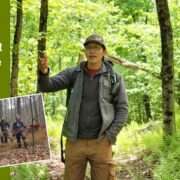
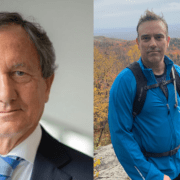
 After which he joined CGI Group as Senior Vice-President – Corporate Development and Strategic Investments from 2003 to 2016 and was Advisor to the Chairman from 2016 to 2018. He is currently Chairman of the Board of the Solidarity Fund QFL since 2018. Over the years, he has been involved in several fundraising events including Centraide of Greater Montreal and the 24 Hours of Tremblant Foundation.
After which he joined CGI Group as Senior Vice-President – Corporate Development and Strategic Investments from 2003 to 2016 and was Advisor to the Chairman from 2016 to 2018. He is currently Chairman of the Board of the Solidarity Fund QFL since 2018. Over the years, he has been involved in several fundraising events including Centraide of Greater Montreal and the 24 Hours of Tremblant Foundation. re Department; supported the construction of the Town Hall with multipurpose rooms; created a participative committee
re Department; supported the construction of the Town Hall with multipurpose rooms; created a participative committee